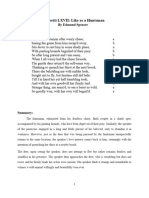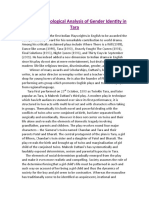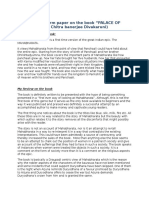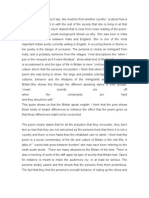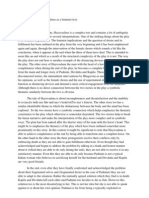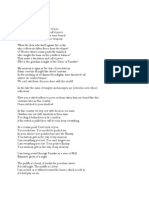Sweet Warrior When Shall I Have Peace With You by Edmund Spenser's Whole Summary
Uploaded by
souravroy35467Sweet Warrior When Shall I Have Peace With You by Edmund Spenser's Whole Summary
Uploaded by
souravroy35467"Sweet Warrior, When Shall I Have Peace with You" is a sonnet from Edmund Spenser's sonnet
sequence "Amoretti." In this sonnet, Spenser uses the extended metaphor of a warrior to describe
the conflict between the speaker and his beloved, as well as his longing for reconciliation and peace.
### Summary:
**Lines 1-4**:
The sonnet opens with the speaker addressing his beloved as a "sweet warrior." He questions when
he will finally have peace with her. The speaker laments that, despite his sincere love and efforts to
win her favor, she continues to resist him, causing him great emotional turmoil.
**Lines 5-8**:
The speaker describes his beloved's resistance as a "war" she wages against him. He portrays himself
as a suffering lover, weary from the constant battle of trying to gain her affection. The imagery of war
underscores the intensity of his emotions and the struggle he faces in seeking her love.
**Lines 9-12**:
The speaker pleads for mercy, asking his beloved to end the conflict and allow him some respite. He
acknowledges her power over him and admits that he is entirely at her mercy. The use of military
imagery continues, with the speaker portraying himself as a conquered soldier seeking peace from
his victorious opponent.
**Lines 13-14**:
In the final couplet, the speaker expresses his hope that his beloved will eventually relent and grant
him the peace he desires. He wishes for an end to the strife and for the beginning of a harmonious
relationship, where love can flourish without the constant battle.
### Themes:
1. **Love as a Battle**:
- The sonnet uses the metaphor of war to depict the struggles and conflicts inherent in romantic
relationships. The speaker's pursuit of his beloved is portrayed as a battle, with emotional wounds
and a longing for a truce.
2. **Yearning for Reconciliation**:
- The speaker's desire for peace and reconciliation is central to the poem. He longs for an end to
the conflict and for mutual understanding and love to prevail.
3. **Power Dynamics in Love**:
- The poem explores the power dynamics between the speaker and his beloved. The beloved is
depicted as a warrior with the power to grant or withhold peace, while the speaker is portrayed as
vulnerable and pleading for mercy.
### Conclusion:
"Sweet Warrior, When Shall I Have Peace with You" by Edmund Spenser is a poignant exploration of
the conflicts and power struggles in romantic relationships. Through the extended metaphor of war,
Spenser conveys the speaker's emotional turmoil and his earnest desire for reconciliation and
harmonious love. The sonnet captures the intensity of love's struggles and the hope for eventual
peace and mutual affection.
You might also like
- Capoch's Build Orders Guide - English - October 2022No ratings yetCapoch's Build Orders Guide - English - October 202293 pages
- Cartridges 76mm X 636 For All Types of OTO Melara Guns 76mm L/62100% (2)Cartridges 76mm X 636 For All Types of OTO Melara Guns 76mm L/628 pages
- "THE LAND OF THE HALF-HUMANS" by Thangjam IbopishakNo ratings yet"THE LAND OF THE HALF-HUMANS" by Thangjam Ibopishak9 pages
- Meaning, Concept and Nature of Gandhian Swaraj: Chapter - 4No ratings yetMeaning, Concept and Nature of Gandhian Swaraj: Chapter - 434 pages
- Elements of Indian Ness in Jayanta Mahapatra50% (2)Elements of Indian Ness in Jayanta Mahapatra9 pages
- Abstract On "The Railway Clerk" by Nissim EzekielNo ratings yetAbstract On "The Railway Clerk" by Nissim Ezekiel1 page
- Toru Dutt (1956 - 1877) : Our Casuarina Tree100% (1)Toru Dutt (1956 - 1877) : Our Casuarina Tree17 pages
- Compiled Summary of Dicing and Sequel To Dicing100% (1)Compiled Summary of Dicing and Sequel To Dicing26 pages
- English Literature - Small-Scale Reflections On A Great House0% (1)English Literature - Small-Scale Reflections On A Great House3 pages
- The Story of The Two Lady Rams' in BriefNo ratings yetThe Story of The Two Lady Rams' in Brief1 page
- The Distant Window Chapter 7-12 Summary - GetSetNotesNo ratings yetThe Distant Window Chapter 7-12 Summary - GetSetNotes7 pages
- "THE STRANGE AFFAIR OF ROBIN S NGANGOM" by Robin Ngangom100% (1)"THE STRANGE AFFAIR OF ROBIN S NGANGOM" by Robin Ngangom16 pages
- #Discuss The Critical Appreciation of "Freedom To The Slave"100% (2)#Discuss The Critical Appreciation of "Freedom To The Slave"2 pages
- Question 1: Discuss The Concept of Sthala Purana' With Reference To The Foreword To Kanthapura by Raja RaoNo ratings yetQuestion 1: Discuss The Concept of Sthala Purana' With Reference To The Foreword To Kanthapura by Raja Rao3 pages
- Comment On The Title of Abhijyanamshakuntalam100% (1)Comment On The Title of Abhijyanamshakuntalam3 pages
- Critical Appreciation of Song of Radha, The MilkmaidNo ratings yetCritical Appreciation of Song of Radha, The Milkmaid3 pages
- The Pioneer of The Great Victorian Renaissance100% (2)The Pioneer of The Great Victorian Renaissance5 pages
- Alexander's Feast: or The Power of Music An Ode in Honor of ST Cecilia's Day - John Dryden About Poet100% (1)Alexander's Feast: or The Power of Music An Ode in Honor of ST Cecilia's Day - John Dryden About Poet4 pages
- Significance of The Title of Arms and The Man by Bernard ShawNo ratings yetSignificance of The Title of Arms and The Man by Bernard Shaw2 pages
- A Critical Analysis of Poem - No Second Troy - by William Butler Yeats100% (2)A Critical Analysis of Poem - No Second Troy - by William Butler Yeats4 pages
- Sovereignty, Security and Defense of The Nation.No ratings yetSovereignty, Security and Defense of The Nation.7 pages
- What Are The Similarities and Differences Between Conflict Resolution and Violence PreventionNo ratings yetWhat Are The Similarities and Differences Between Conflict Resolution and Violence Prevention2 pages
- Java in a nutshell 2nd ed Edition David Flanagan download pdf100% (7)Java in a nutshell 2nd ed Edition David Flanagan download pdf27 pages
- The American Civil War: Additional RulesNo ratings yetThe American Civil War: Additional Rules5 pages
- No - Minister Portfolio: S / N o Name Portfoli o Phon e ImageNo ratings yetNo - Minister Portfolio: S / N o Name Portfoli o Phon e Image29 pages
- 1 អនុក្រឹត្យលេខ៣២ ស្ដីពីរបបសន្តិសុខសង្គមផ្នែកប្រាក់សោធនសម្រាប់បុគ្គលNo ratings yet1 អនុក្រឹត្យលេខ៣២ ស្ដីពីរបបសន្តិសុខសង្គមផ្នែកប្រាក់សោធនសម្រាប់បុគ្គល13 pages
- Active Electronically Scanned Array - Wikipedia, The Free EncyclopediaNo ratings yetActive Electronically Scanned Array - Wikipedia, The Free Encyclopedia10 pages
- Raytheon - AN - APX-100 Mark XII - Mode S IFF TransponderNo ratings yetRaytheon - AN - APX-100 Mark XII - Mode S IFF Transponder3 pages
- International Relations (10th Edition, 2013-2014 Update) Joshua S. Goldstein - The full ebook version is available, download now to explore100% (1)International Relations (10th Edition, 2013-2014 Update) Joshua S. Goldstein - The full ebook version is available, download now to explore59 pages
- Time Line Road To Democracy Essay MaterialNo ratings yetTime Line Road To Democracy Essay Material4 pages
- Grudic Italy p1 and Mussolini p2 Part 2 Consolidation of PowerNo ratings yetGrudic Italy p1 and Mussolini p2 Part 2 Consolidation of Power39 pages
- 500 LB Multi-Purpose Rigid GP Bomb: Elbit Systems - Land Air To GroundNo ratings yet500 LB Multi-Purpose Rigid GP Bomb: Elbit Systems - Land Air To Ground4 pages
- Company:: Printed On: Mar 09 2024 10:54No ratings yetCompany:: Printed On: Mar 09 2024 10:5418 pages
- Air Defence Artillery in India Pakistan War of 1971No ratings yetAir Defence Artillery in India Pakistan War of 19714 pages




